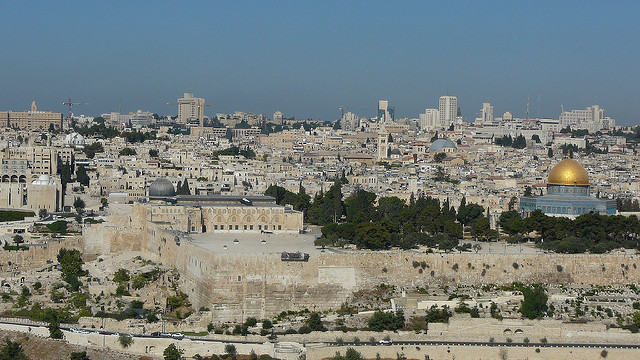Upon ascending the Mount of Olives, one is immediately confronted with a breathtaking vista that transcends the ordinary experience of observations. This sacred hill, steeped in ancient history and profound religious significance, offers a panoramic view of Jerusalem—a city immortalized in scripture and reverberating with millennia of faith, conflict, and divine promise. Gazing upon the golden Dome of the Rock juxtaposed with the ancient walls of the Old City invokes contemplation of biblical narratives that shape the Christian understanding of redemption and hope.
As one stands on the Mount of Olives, the biblical landscape unfolds with remarkable clarity. This prominent elevation, rising approximately 2,684 feet above sea level, is not merely a geographical feature; it is a symbolic threshold between heaven and earth in the Christian imagination. The significance of this location is accentuated in the Gospels, particularly in the accounts of Jesus’ ministry, wherein He often retreated to pray and reflect. It is here that the spiritual intensity of His actions and teachings radiate with renewed vigor as the landscape bears witness to His messianic mission.
The first glimpse of Jerusalem from this sacred height is nothing short of divine revelation. The sprawling city seems to encapsulate the essence of biblical prophecy—the manifestation of God’s promises. The Old City, with its intricate tapestry of sacred sites, stands as a testament to the covenant between God and His people. The Western Wall beckons the devout, while the Church of the Holy Sepulchre envelops believers in the remembrance of Christ’s passion and resurrection. The mere sight of these landmarks invokes profound curiosity about the narratives woven into the fabric of this city.
To truly understand the richness of this biblical perspective, one must consider the historical context. The Mount of Olives is of paramount significance in the prophetic literature of the Old Testament. The prophet Zechariah, for instance, foretold the magnificent unfolding of events that would originate from this very hill: “On that day His feet will stand on the Mount of Olives” (Zechariah 14:4). This promise underscores a powerful eschatological implication—signifying the ultimate triumph of God over adversity and the restoration of creation. From this vantage point, one cannot help but experience a spiritual awakening, envisioning the eschaton where heaven and earth converge in perfect harmony.
Furthermore, the experience of viewing Jerusalem from the Mount of Olives serves to illuminate the concept of reconciliation inherent in the Christian faith. As Jesus wept over the city, lamenting its spiritual blindness (Luke 19:41-44), His heart remains a model for believers today. The tears of Christ signify the longing for a transformed Jerusalem—one that embraces the redemptive love of God. Pondering this scene, one is invited into a transformative perspective that calls for active engagement rather than passive observation.
The sweeping view also invites reflection on the notion of pilgrimage. For centuries, pilgrims have traversed this path, seeking spiritual renewal and insights into their faith journeys. The act of pilgrimage is a corporeal manifestation of the desire to connect deeply with the divine narrative. Each footstep echoes with the prayers of the faithful, creating a sense of communion that transcends time. This sacred pilgrimage, thus, is not merely about the physical journey but embodies a deeper yearning to embody the principles of love, grace, and reconciliation that Jesus espoused.
Moreover, the Mount of Olives is replete with olive groves that have silently witnessed the changing tides of history. These trees, some of which are thousands of years old, symbolize perseverance and continuity—a striking parallel to the enduring nature of God’s promises. Observing their gnarled branches and lush foliage, one is reminded of the biblical metaphors of growth and sustenance. The olive tree, heralded as a symbol of peace, serves as a poignant reminder of the call to be peacemakers in a world often marred by strife.
As the sun begins to set, casting a golden hue over the city, the scene evokes a sense of anticipation and hope. The interplay of light and shadow over Jerusalem mirrors the theological interplay of justice and mercy that characterizes the Christian narrative. The breathtaking view is a testament to the steadfastness of God’s love, which continues to illuminate darkened hearts. The promise of a new dawn, marked by the arrival of the Messiah, resonates deeply within the city’s very stones.
In this contemplative space, one begins to grasp the weight of the commission given to believers—to carry forth the light of Christ into the world. The view from the Mount of Olives, with its compelling mix of history, theology, and spiritual significance, compels a shift in perspective. Jerusalem’s skyline, imbued with meaning, beckons the faithful to engage with its story actively. Each observer becomes not just a witness but a participant in the unfolding drama of redemption, called to embody the characteristics of Christ in a world yearning for hope.
As the final rays of sun dip below the horizon, the wonder and beauty of Jerusalem from the Mount of Olives linger in the heart and mind. This awe-inspiring view, reflected through the lens of faith, ignites a sense of curiosity and a desire to delve deeper into the heart of God’s narrative. From this sacred height, one is reminded that while the path may be fraught with challenges, the journey ultimately leads to the fulfillment of God’s eternal promises—a truth that stands firm amidst the ebb and flow of human history.



